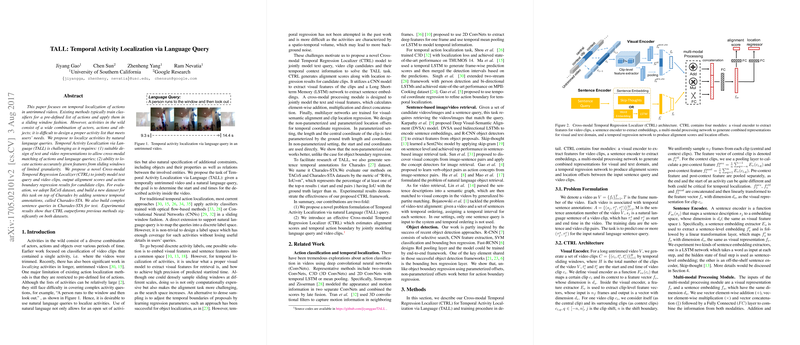Temporal Activity Localization via Language Queries: An Examination of the TALL Framework
The paper, "TALL: Temporal Activity Localization via Language Query," presents an innovative approach to the complex task of localizing activities in untrimmed videos using natural language queries. Traditional methods rely heavily on predefined action labels applied in a sliding window fashion; however, they often fail to capture the vast array of activities that occur in real-world scenarios. This research proposes a solution that leverages the richness of natural language to enable more flexible and comprehensive activity localization.
Overview of the TALL Framework
The proposed Temporal Activity Localization via Language (TALL) framework introduces a novel method for mapping natural language queries to video segments. The core challenge lies in designing representations that enable effective cross-modal matching between text and video and accurately locating actions within a limited granularity setup due to sliding windows.
To address these challenges, the authors present the Cross-modal Temporal Regression Localizer (CTRL), a model capable of integrating text queries and video clips to generate alignment scores and refine temporal boundaries of potential activity clips. CTRL employs a multi-layer architecture consisting of a visual encoder, sentence encoder, cross-modal processing module, and temporal regression network. The incorporation of non-parameterized temporal regression for activity boundary adjustment demonstrates superior efficacy over traditional parameterized approaches.
Evaluation and Results
The evaluation utilizes the TaCoS and Charades-STA datasets, with the latter developed by augmenting the Charades dataset with temporal sentence annotations, forming a robust testbed for TALL. This work significantly outperforms existing methods such as visual-semantic alignment models (VSA-RNN, VSA-STV) and classifiers based on predefined verbs and objects, demonstrating clear advantages in leveraging the regression-based approach in TALL tasks. The use of metrics such as Recall@{1,5} with varying IoU thresholds emphasizes the model's strong performance across different levels of granularity.
Implications and Future Directions
The results indicate that the CTRL model's integration of non-parameterized offset regression effectively improves temporal localization in response to natural language queries, enhancing both theoretical understanding and practical applications like video indexing and retrieval. The methodological improvements in cross-modal alignment present valuable insights into the complex mapping between language and video, paving the path for future exploration.
Prospective advancements may encompass extending this work to more sophisticated sentence structures and multi-activity scenarios, as demonstrated by experiments with complex queries. Continued development in this direction could enhance the adaptability and intelligence of AI systems tasked with understanding and processing natural language in dynamic visual environments.
Conclusion
The introduction of TALL marks a significant advance in the field of temporal activity localization. By allowing for natural language queries and improving temporal precision through novel architectural innovations, this research contributes substantial progress to the understanding and application of cross-modal temporal localization frameworks. As the field progresses, the insights and methodologies introduced here are poised to influence a range of AI-driven video analysis applications.
